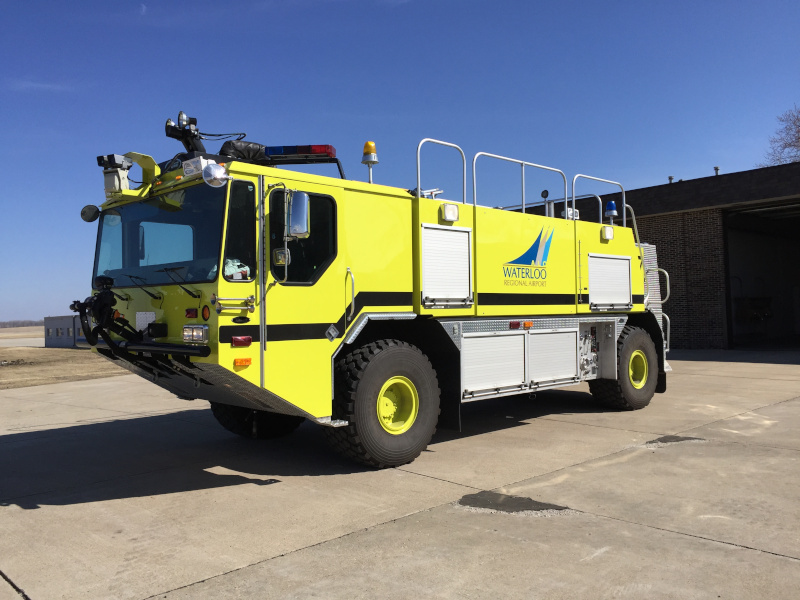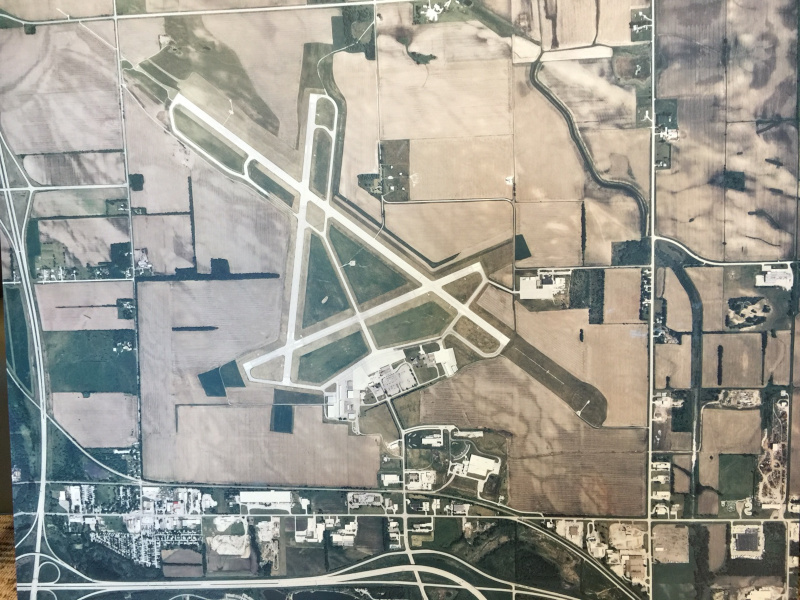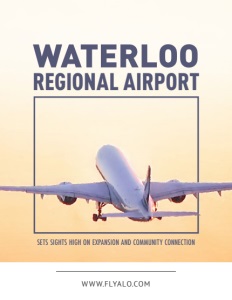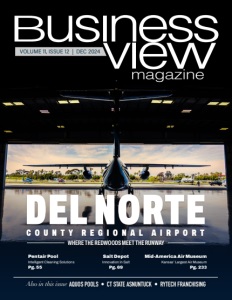Waterloo Regional Airport
Sets Sights High on Expansion and Community Connection
Investing in expanded air service, private hangar development, and stronger ties to the local economy
Waterloo Regional Airport, a key transportation hub in northeastern Iowa, might not yet have the brand recognition of larger Midwestern airports, but it boasts significant infrastructure and ambitious plans. Located just a few miles outside Waterloo’s downtown, the airport serves business and leisure travelers through an 8,399-foot runway that can accommodate aircraft from small private planes to larger jets.
“Our runway can handle pretty much any business aircraft flying today,” says Steven Kjergaard, the airport’s Director of Aviation. This range, he explains, includes single-engine prop planes up to mid-sized passenger jets. Livingston Aviation, a full-service Fixed Base Operator (FBO), operates on-site, providing refueling, ground services, and maintenance. “Livingston has the ability to do maintenance, which is becoming more unusual in the aviation world,” he notes.
Kjergaard is a seasoned leader in airport management, with a career that has taken him to airports across the country, including stints in Coeur d’Alene, Idaho, and Williston, North Dakota. He began his career in airport operations in Teterboro, New Jersey, one of the busiest private aviation airports in the nation, giving him a comprehensive foundation in the logistical and regulatory challenges of the industry. “I’ve been an airport director for 13 or 14 years,” he says. Along the way, he’s built expertise in FAA regulations and leasing policies.
Expanding Infrastructure and Commercial and Corporate Services
Waterloo Regional Airport is currently undertaking a master plan update to spur growth and tackle critical infrastructure considerations, particularly regarding runway specifications. The FAA is increasingly emphasizing “right-sizing” runways to better align with the types of aircraft each airport serves. For Waterloo, this means evaluating the fleet mix—essentially the types and sizes of planes using the airport regularly—to determine whether the current runway lengths and widths meet projected needs. “Runway size and length will be a major discussion point as we plan for the next phase,” Kjergaard says.
Alongside these infrastructure considerations, the airport is actively cultivating its role as a gateway for leisure travelers, with daily flights to major hubs and a steady stream of private and charter aircraft. The airport’s only commercial service currently includes two daily American Airlines flights to Chicago O’Hare, but Kjergaard sees room for more. “We see a lot of leakage to other airports—Cedar Rapids, Des Moines, even Minneapolis, and Chicago,” he says, referring to residents traveling to larger cities to catch flights. For him, this isn’t a challenge; it’s a sign of untapped potential.
In addition to the scheduled commercial flights, the airport also hosts charter services through partnerships with gaming and entertainment companies. Sun Country Airlines operates flights to casino destinations under the Caesars Rewards program, filling the void left by Swift Air’s exit. These flights appeal to a distinct customer base, bringing travelers looking for leisure trips to cities like Laughlin. “Caesars is interested in maintaining flights to certain destinations, and we work with them to make it happen,” Kjergaard says.
Corporate and private aviation similarly play an equally significant role in Waterloo’s operations, primarily driven by regional industries’ needs. “We see a steady mix of traffic from all over, with major manufacturers like John Deere relying on the airport for corporate travel,” Kjergaard says. The airport wants to develop more hangar space to support corporate and private aviation. “We’re working on securing space for future hangar development,” he explains. “The demand for private hangar space is rising nationwide, and our proximity to local businesses and ease of access makes it an appealing option for private aircraft operators.”

Investing in Careers and Community
For Waterloo Regional Airport, the focus on growth goes beyond flights and infrastructure; it extends into the community, aiming to cultivate a future workforce in aviation. This vision includes expanding training and career opportunities in flight and aircraft maintenance—a response to industry-wide workforce challenges. “We’re working to support Livingston Aviation,” says Kjergaard, referring to the airport’s Fixed-Base Operator that also provides flight training, making the airport a potential launching pad for aspiring aviators and technicians alike.
Kjergaard envisions strengthening these opportunities by collaborating with local educational institutions, although funding still needs to be improved. He notes that the airport has begun conversations with area community colleges about developing aviation programs, specifically in maintenance. “We want to provide space, and, if possible, funding, to support these kinds of developments,” he explains. Waterloo’s proximity to the University of Dubuque, which has an established flight program, adds to the potential for educational partnerships.
To spark interest in aviation from a younger age, the airport collaborates with its local chapter of the Experimental Aircraft Association (EAA), which hosts youth-focused programs to inspire the next generation of pilots and aviation enthusiasts. The EAA chapter runs “Young Eagles” flights twice a year, allowing kids to experience a small aircraft firsthand. “They typically have between 200 and 300 kids per event,” says Kjergaard. For many of these young participants, it’s their first time on an airplane, and Kjergaard believes that early exposure to aviation can plant seeds for future careers. The airport assists with logistics to ensure these events go smoothly.
Kjergaard also hints at broader plans to engage the community with the airport’s operations and possibilities. He’s considering organizing an open house or fly-in event, potentially as soon as next year, to draw local families and aviation enthusiasts to the airport. “The airport board wants to make this happen, and I’ve seen these events have a big impact at other airports,” he says. Such gatherings showcase aircraft and help residents understand the role of the airport and its value to the region, serving as a bridge connecting the public with the often-overlooked world of aviation.
Strategic Infrastructure and Economic Development
Waterloo Regional Airport’s capital improvement plans are guided by a long-term strategy to ensure robust infrastructure, operational efficiency, and seamless alignment with regional economic development goals. With significant and minor runway projects on the horizon, Kjergaard is preparing the airport for decades of growth and sustainability.
“Next year, we’re planning a pavement assessment to understand our current strengths and needs,” he explains. This assessment will set the stage for a series of upgrades, including a complete rehabilitation of the airport’s primary runway. In preparation, Kjergaard is focusing on optimizing the smaller crosswind runway. “We want to get 18/36 in the best condition possible before starting the major work on 12/30, so it can handle increased traffic during the main runway’s phased renovation,” he notes.
The airport also addresses practical needs specific to Midwestern weather, particularly snow management. Kjergaard points out that “we’re using entitlements to purchase snow removal equipment” to enhance operational readiness during winter storms. Ensuring that the airport can stay open and accessible during snow events is crucial for both commercial and private aviation and emergency services. Given the unpredictability of Midwest winters, Kjergaard sees this investment as essential for maintaining uninterrupted service.
Beyond physical infrastructure, Waterloo Regional Airport is making strides in passenger safety and security with advanced technology through its partnership with the TSA. Kjergaard asserts that the airport was the first in Iowa to receive one of the latest X-ray screening machines, a nod to a proactive approach to security. “The TSA has done a great job in keeping us ahead of the curve,” he says. Kjergaard acknowledges that this is a foundation to build on, and he remains steadfast in pushing for even more cutting-edge security technology as it becomes available.

Leveraging Land and Economic Partnerships
The airport’s strategic location within an industrial park offers additional avenues for growth in related commercial and industrial opportunities. The city of Waterloo owns land in nearby industrial zones that are available for development.
“We have aeronautical land to accommodate quite a bit, due to a runway closure about ten years ago,” Kjergaard says, describing how the decommissioned third runway created valuable real estate for potential airport expansions and partnerships. Around the airport, businesses range from a chocolate pudding manufacturer to technology firms producing circuit boards, along with multiple freight operations. This industrial ecosystem aligns well with the airport’s logistical capabilities and adds to its potential as an economic driver for the city.
Collaboration with local government and economic organizations is another key part of Kjergaard’s approach to maximizing the airport’s impact. As a city department, the airport maintains close ties with other municipal staff, ensuring that Waterloo’s broader economic and tourism initiatives are closely coordinated. “Being connected with the city and county is extremely important,” he emphasizes. “We also partner with Growth Cedar Valley, an organization that promotes economic development and tourism in the area.” These partnerships help align the airport’s operations with the region’s goals for attracting visitors and boosting the local economy.
Tourism is increasingly important to the area, with attractions such as the University of Northern Iowa and a revitalized downtown Waterloo drawing visitors year-round. “The city has put a significant amount of money into the downtown area, including a renovated convention center and a visually striking light installation on the bridges spanning the Cedar River,” Kjergaard explains, noting that the enhanced riverfront experience and convention center upgrades are intended to attract both business and leisure travelers. Nearby Cedar Falls, with its charming small-town appeal, provides a contrasting experience for visitors, rounding out the region’s tourism offerings.
Prioritizing Growth and Connection
With years of experience in aviation management, Kjergaard’s focus at Waterloo Regional Airport is not just on operational improvements but on strengthening connections within the community and elevating the airport’s role in regional growth. “My goal is to continue to integrate myself into the community at a personal level,” he says, adding that strong local relationships are key to the airport’s success.
One of Kjergaard’s primary ambitions for Waterloo Regional Airport is to attract additional air service options, particularly low-cost carriers. With the region’s travelers frequently driving to larger airports in Cedar Rapids, Des Moines, or even Minneapolis for a wider range of flights, Kjergaard sees an opportunity to bring some of that traffic back to Waterloo. “We’re looking to expand air service, whether that means a low-cost carrier or just more consistent flights in and out,” he explains. “My aim is to make the airport more accessible for business and leisure travelers, potentially reducing travel time and costs for the community.”
Alongside improving air service, Kjergaard is finding ways to boost private development at the airport. He’s particularly interested in facilitating private hangar construction. “We’re looking to shoehorn in some type of private hangar development to provide local businesses and private pilots with customized space for their aircraft while generating new revenue streams for the airport,” he says, describing his vision for a more self-sustaining airport that can meet the diverse needs of its users.
As Kjergaard sees it, these goals—enhanced air service, private development, and community integration—are all interconnected. With each initiative, Waterloo Regional Airport moves closer beyond just a transit point to become a key contributor to regional prosperity. His approach hinges on the belief that an airport’s success is measured not only by its infrastructure but also by the strength of its relationships with its passengers and its community.
AT A GLANCE
Waterloo Regional Airport
What: Regional airport focused on expanding air service, enhancing infrastructure, and supporting local economic growth
Where: Waterloo, Iowa
Website: https://flyalo.com/
PREFERRED VENDORS
Stickfort Electric – https://stickfortelectric.com/
Aircraft Storage Hangars
Commercial Retail
Multifamily Dwellings
Manufacturing Facilities
Custom Home Design
Solar Power Distribution
Building Automation Systems
Health Care Service Providers
Office Administration Facilities
Stickfort Electric is a multidimensional electrical contractor here within the Cedar Valley, providing a variety of services since 1957. Whether your needs are commercial, industrial, residential or BAS, we can fulfill your electrical requirements. Our mission is to assist our customers in reaching their expectations on time and on budget. Your success is what we strive for in each installation or service call.
We specialize in design build projects to offer our customers the ability to uniquely create what they want and need. We incorporate years of experience and knowledge to help our customers make decisions for the present, with options for the future. Our diligent commitment to achieve project completion on time, on budget and with the highest quality, has given Stickfort Electric an undeniable reputation.
Each project has value and worth to us. It may be a patio and pool remodel, commercial solar install, or an industrial manufacturing facility. Our approach is simple: discover what is needed, work with our customers to meet their budgetary goals and install their electrical systems in the timeliest manner as possible. We welcome the opportunity to plan your next project and then help get you there.
JSA Development, LLC – www.jsadevelopment.com
JSA Development owns, operates and rehabilitates historic commercial and residential property in the Cedar Valley region. With over 25 years of experience planning rehabilitations, managing and operating historic buildings in the upper Midwest, we have seen many exciting projects. From our office in Downtown Waterloo, we partner with communities, investors, architects and contractors to build stronger city centers. These stronger centers help build on the community’s legacy while better positioning themselves to be competitive into the future.
JSA Development is proud to support the Waterloo Regional Airport. As the gateway to the Cedar Valley, ALO is an important part of regional economic development. We are excited about the enhanced service and larger, two-class aircraft that will be serving ALO beginning in June 2025.
If you are looking for your next office, retail location or residence, please visit our website www.jsadevelopment.com or call 319-233-3147. If you would like to see how we can work together on your project, call or email livedowntown@jsadevelopment.com



